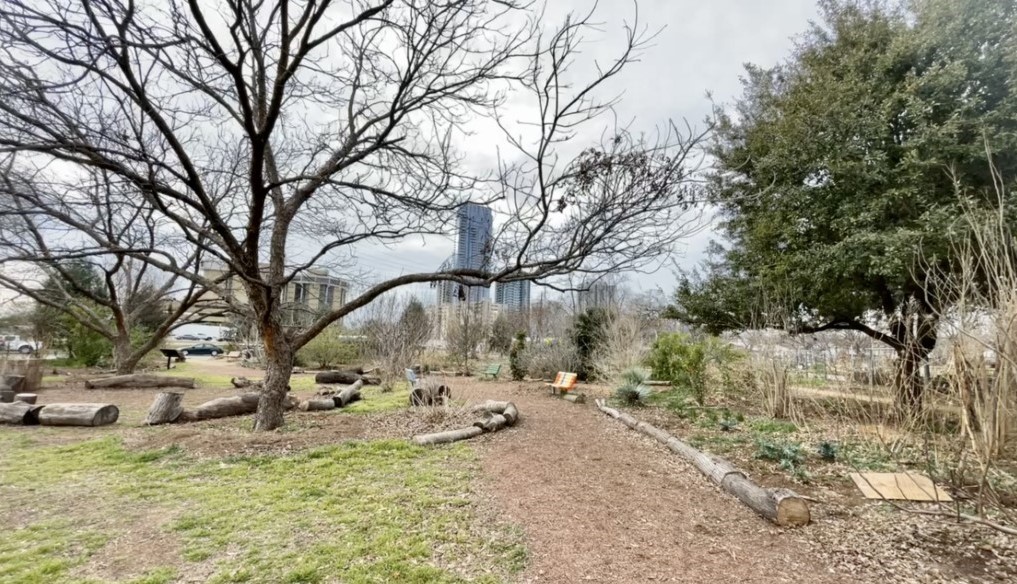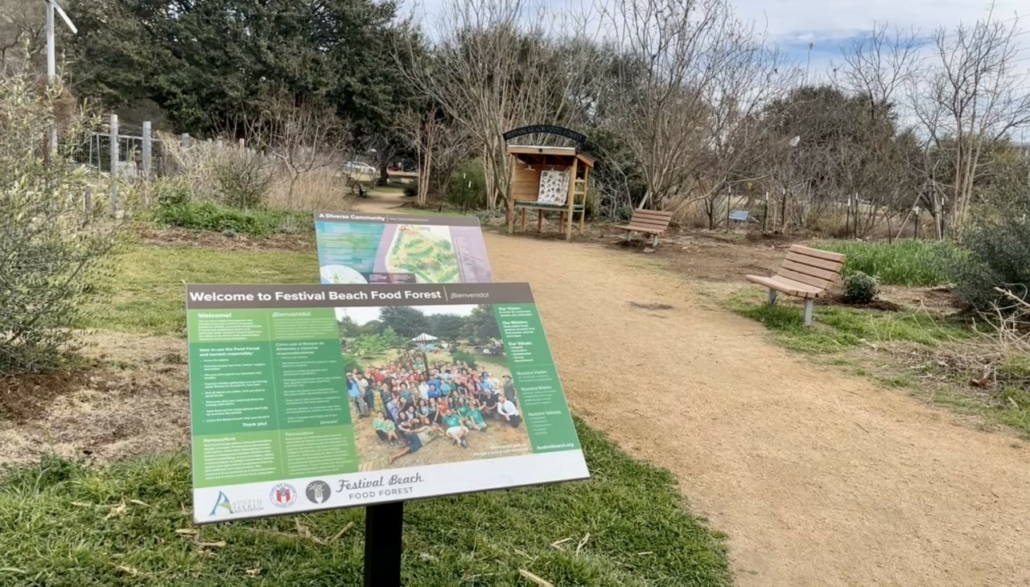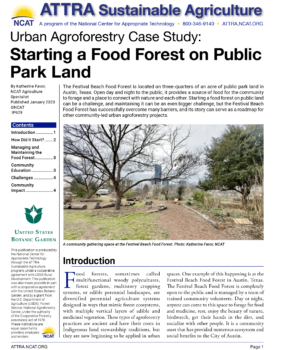Urban Agroforestry Case Study: Starting a Food Forest on Public Park Land

A community gathering space at the Festival Beach Food Forest. Photo: Katherine Favor, NCAT
By Katherine Favor, NCAT Agriculture Specialist
Abstract
The Festival Beach Food Forest is located on three-quarters of an acre of public park land in Austin, Texas. Open day and night to the public, it provides a source of food for the community to forage and a place to connect with nature and each other. Starting a food forest on public land can be a challenge, and maintaining it can be an even bigger challenge, but the Festival Beach Food Forest has successfully overcome many barriers, and its story can serve as a roadmap for other community-led urban agroforestry projects.
Introduction
Food forests, sometimes called multifunctional woody polycultures, forest gardens, multistory cropping systems, or edible perennial landscapes, are diversified perennial agriculture systems designed in ways that mimic forest ecosystems, with multiple vertical layers of edible and medicinal vegetation. These types of agroforestry practices are ancient and have their roots in Indigenous land stewardship traditions, but they are now beginning to be applied in urban spaces. One example of this happening is at the Festival Beach Food Forest in Austin, Texas. The Festival Beach Food Forest is completely open to the public and is managed by a team of trained community volunteers. Day or night, anyone can come to this space to forage for food and medicine, rest, enjoy the beauty of nature, birdwatch, get their hands in the dirt, and socialize with other people. It is a community asset that has provided numerous ecosystem and social benefits to the City of Austin.
How Did it Start?
Jodi Lane, executive director of Fruitful Commons and a cofounder of the Festival Beach Food Forest, explains that the Festival Beach Food Forest was born out of a master-planning process that began after a nearby power plant was decommissioned. The process first and foremost involved getting input from community members and neighbors about what they wanted to see done with 90 acres of public park land along Ladybird Lake. To engage as many people as possible in this process, a coalition of neighbors and some local nonprofits hosted regular potlucks to gather community members for listening sessions. For two years, the City, nonprofits, and community members listened and brainstormed together, and finally the idea of a public community food forest was born.

The Festival Beach Food Forest has no fences and is open 24/7 for the public to access. Photo: Katherine Favor, NCAT
These local stakeholders decided that a perennial food forest was a better option for this space than a community garden for several reasons. First, the community wanted the space to remain completely open to the public, day or night. Community gardens often have fences around them to protect people’s rented plots, and fences can unintentionally make some community members feel that they aren’t welcome in those spaces. The idea of an open food forest, with no fences, no privately rented plots, and no hours of operation fit more with the community’s vision for a public space that was open to all. Secondly, the community wanted the food produced in this space to be owned collectively by the commons, as opposed to belonging to individuals. In most community gardens, garden plots are stewarded by individuals who lease plots, but at the Festival Beach Food Forest, it was important that all the food in the area be both produced by and accessible to anyone who passed through. Additionally, perennial crops in food forests generally require less maintenance than annual crops in community gardens.
Once the community decided what they wanted to see on their public park land, it took several years to implement their vision. First, the City did soil testing to make sure the site was not contaminated and that it was able to support healthy food production. Next, food forest designers looked at city maps to see what below- and above-ground utilities were in the area, to ensure that power lines, buried gas lines, and other buried utilities would not be damaged in the process of implementing the food forest. Luckily, the area was utility-free. Connecting to water was the next step. Fortunately, the adjacent community
garden was already connected to underground water lines, and the Festival Beach Food Forest arranged an agreement to connect to that water source.
The Festival Beach Food Forest also had to enter into an agreement with a fiscal sponsor, Urban Patchwork, that carried the requisite insurance, before allowing people into the space. General liability insurance, automobile insurance, and several other types of insurance policies were necessary to make sure that the food forest was set up in the safest way possible.
The next step was to establish a land agreement with the City of Austin’s Parks and Recreation Department. Public park land in Austin is under the jurisdiction of the city’s Parks and Recreation Department, but since the idea of a food forest was something that had never been implemented before on public park land in Texas, it took several years to establish a working maintenance agreement. The City of Austin agreed to provide some maintenance of the space, including mowing grassy areas, pruning overstory trees, and maintaining ADA-friendly pathways throughout the food forest. It was also determined that management of understory crops, community education, and community organizing would be done mostly by volunteers.
However, there are many other tasks associated with maintaining a food forest beyond just landscape and volunteer management. Many of these tasks were beyond the capacity of the City and community volunteers, so a unique 501(c)(3)
nonprofit called Fruitful Commons was established to be the fiscal sponsor of the Festival Beach Food Forest. Fruitful Commons took over some of the other behind-the-scenes tasks, like accounting, bookkeeping, grant writing, managing insurance policies, and negotiating with city departments for the expansion of the Festival Beach Food Forest. They are also currently assisting the Food Forest core team to hire two full-time contract positions – a skilled forest steward to manage the plants and coordinate food forest maintenance, and a community organizer to manage volunteers, coordinate events, and reach out to the community to make the project more inclusive and diverse in its membership and leadership.
Managing and Maintaining the Food Forest
Having Fruitful Commons take on the administrative tasks gave the Festival Beach Food Forest core team volunteers more time to concentrate on reviving educational and community-building activities and the day-to-day maintenance of the space. Aly Tharp, Community Engagement Coordinator, explains that the Festival Beach Food Forest has cultivated a strong team of educated, engaged, and committed volunteers who are dedicated to managing the space.
The volunteer force of the Festival Beach Food Forest is coordinated through a model called sociocracy, or dynamic governance, which empowers volunteers by providing helpful processes for teams or “circles” that take ownership and responsibility for the various aspects of stewarding the project. Festival Beach Food Forest has organized its volunteer positions into four main teams:
- Plant Circle – responsible for planting, mulching, weeding, fixing irrigation leaks, pruning, and harvesting.
- People Circle – responsible for managing new volunteers, creating educational opportunities, hosting events, and doing
outreach to the community. - Prosper Circle – focused on budgeting, finances, grant writing, and grant reporting.
- Purpose Circle – focused on mission, vision, and strategic planning.
All these teams are composed of committed and trained volunteers who show up regularly, as if it were a part-time job. Those dedicated volunteers are then put in charge of managing volunteers who might come less regularly. For instance, Plant Circle
Volunteer Leads host weekly open volunteer days, in which anyone from the community can show up to work in the food forest. At these weekly volunteer days, volunteer leads educate less-experienced volunteers in simple maintenance tasks. Plant Circle Volunteer Leads also host monthly plant education workshops, at which they give walking tours of the food forest and educate people on how to identify and harvest plants. These educational plant walks are usually followed by demonstrations to show what kinds of food dishes, teas, and tinctures you can make using foraged plants. Twice a year, Festival
Beach Food Forest also hosts larger volunteer days with as many as 100 volunteers, through a citywide program called “It’s My Park Day.” These events include educational activities, volunteer opportunities, live music, and potlucks, and they
are great opportunities to get more people involved in food forest activities.
Volunteer management is facilitated with an application called Givepulse, which helps keep track of liability waivers and also helps volunteers track their hours. Outreach to volunteers and community members is done through Festival Beach Food Forest’s newsletter, their social media accounts, and word of mouth.
At any community event, Festival Beach Volunteer Leads always bring water and snacks, in case anyone needs them. They always have a first-aid kit on site, and shade and benches are always accessible for people who need to rest or take breaks.
Community Education
One of the goals of the Festival Beach Food Forest is to educate the community about plants, permaculture design, and regenerative land stewardship. Volunteer days, educational plant walks, and festivals can provide a good opportunity not only for the community to gather, have fun, and make social connections, but also to learn about how to grow food in a regenerative way.

The Festival Beach Food Forest has no fences and is open 24/7 for the public to access. Photo: Katherine Favor, NCAT
One of the more passive ways that Festival Beach Food Forest is educating the community is through signage. The Food Forest obtained grants to create six large educational signs with technical information about the multiple layers of a food forest, water harvesting, and more. There are also smaller QR code signs throughout the food forest, which take people to informational webpages when scanned on a phone. With the help of volunteers, the Food Forest also created a virtual map of all the perennial plants by using geotagging technology.
Challenges
As with any public project, having a food forest on public park land comes with a set of challenges. Because the food forest is open to the public 24/7, vandalism does sometimes occur, and sometimes people dig up plants and take them home for their gardens. However, these occurrences are few and far between, and the benefits of having an open-access food forest far outweigh the disadvantages.
There are also challenges to having volunteers maintain this space. Even when volunteers are well-intentioned, sometimes plants can be pruned incorrectly, trampled, cut down, or mulched over. Making mistakes is a part of the educational process, though, and the benefits of allowing people to work on the land far outweigh any downsides.

Photo: Katherine Favor, NCAT
Community Impact
The Festival Beach Food Forest has provided numerous benefits to the community since its inception in 2012. Although a food forest cannot provide enough free food to support all the families in Austin, it does provide some supplemental food for people in need and, more than anything, it provides a space for people to learn about how to cultivate their own food in an urban setting. People can then take that knowledge back to their own backyards and patios, helping to foster self-reliance.
Providing a connection to nature is another benefit that has come out of this project. The food forest attracts all sorts of birds, butterflies, squirrels, and other wildlife, which can be rare in a city. It provides a space for people in an urban area to
connect with flora and fauna and to take a break from the hustle and bustle of the city.
Providing social connections within the community is another benefit of the Festival Beach Food Forest. Festival Beach has become a place for people to gather in nature, work alongside one another, learn together, and eat together, which has strengthened the social fabric of this area of Austin. Because of the success of the Festival Beach Food Forest, other collectively owned, community-led agriculture projects are now being formed. The nonprofit Fruitful Commons is now not only overseeing management of the Festival Beach Food Forest, but it is also helping support more than 70 other community-led agriculture projects in Texas. With community members’ vision and dedication, and with the administrative help of
Fruitful Commons, the model of public food forests is beginning to scale and expand all over Texas. Th-is network of grassroots, community-led agriculture projects is fostering community resilience, providing food to those in need, and
helping to heal the environment.
Urban Agroforestry Case Study: Starting a Food Forest on Public Park Land
By Katherine Favor, NCAT Agriculture Specialist
Published January 2023
©NCAT
IP629
Slot 667
Version 012723
This publication is produced by the National Center for Appropriate Technology through the ATTRA Sustainable Agriculture program, under a cooperative agreement with USDA Rural Development. This publication was also made possible in part by a cooperative agreement with the United States Botanic Garden, and by a grant from the U.S. Department of Agriculture (USDA), Forest Service, National Agroforestry Center, under the authority of the Cooperative Forestry Assistance Act of 1978. These institutions are equal opportunity providers, employers, and lenders. ATTRA.NCAT.ORG.



